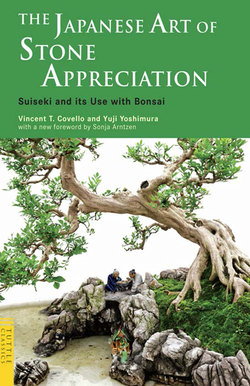Читать книгу Japanese Art of Stone Appreciation - Vincent T. Covello - Страница 5
На сайте Литреса книга снята с продажи.
ОглавлениеList of Illustrations
Asterisk (*) indicates color plate
1. Section of Japanese screen “Portuguese in Japan,” and detail 16, 17
2. Chinese Coastal rock stone 17
3. Human-shaped stone “Li Po Meditating on a Waterfall” 19
4. Distant mountain stone “Floating Bridge of Dreams” 19
5. Landscape garden at Ryoan-ji 21
6. Stone display in a tea-ceremony hut 22
7. Near-view mountain stone suggesting mountain scenery 25
8. Distant mountain stone showing interplay of complementary
aspects 27
9-12. Distant mountain stones 32, 33
13. Near-view mountain stone 34
14. Mountain-stream stone 35
15. Island stone 36
16. Slope stone 36
17. Sandbar stone 36
18, 19. Waterpool stones 37
20. Coastal rock stone 38
21. Cave stone 38
22, 23. Shelter stones 39
24. Boat stone 41
25. Object stone suggesting bear or monster 41
26. Chrysanthemum-pattern stone 43
27. Star-pattern stone 45
*28. Distant mountain stone “Sacred Mount Fuji” 49
*29. Sheet-waterfall stone “Dragon’s Head” 49
*30. Near-view mountain stone with waterfall 50
*31. Japanese garden stone suggesting Mount Shumi 50
*32. Japanese garden stones suggesting Horai 51
*33. Wedded Rocks, Futamigaura bay 51
*34. Mountain stone from the U.S. National Arboretum collection 52
*35. Miniature Coastal rock stone 52
*36. Mountains of the Cascade Range 53
*37. Object stone eliciting a variety of associations 53
*38. Distant mountain stone “Mount Hakkai” 54
*39. Distant mountain stone 54
*40. Near-view mountain stone 54
*41. Thread-waterfall stone 55
*42. Sheet-waterfall stone 55
*43. Dry waterfall stone 56
*44. Mountain-stream stone 56
*45, *46. Plateau stones 57
*47. Slope stone 57
*48. Reef stone 58
*49. Waterpool stone 58
*50. Shelter stone 58
*51, *52. Tunnel stones 59
*53, *54. Thatched-hut stones 60
*55, *56. Object stones suggesting animals 60, 61
*57. Red stone 61
*58. Neodani chrysanthemum-pattern stone 62
*59. Biseki 62
*60. Moon-pattern stone 63
*61. Tiger-stripe-pattern stone 63
*62. Snake-pattern stone 63
*63. Nachiguro stone 64
*64. Furuya stone 64
65(a), (b). Distant mountain stone on dai/in suiban 68
66(a)-(c). Relationship between size of suiban and suiseki 69
67-70. Various suiban 70, 71
71. Distant mountain stone in suiban filled with sand and water 72
72. Thatched-hut stone in soil covered with moss and short grasses 72
73. Weak stone placement 73
74(a)-(c). Placement of suiseki in suiban 74
75. Island stone with bronze miniature 75
76-78. Distant mountain stones in various displays 76, 77
79. Stands used for displaying suiseki 78
80. Rugged Mountain stone displayed on rectangular table 79
81 (a), (b). Poor choices of stands 80
82. Miniature suiseki and planters 81
83, 84. Poor displays 82
85. Plateau stone displayed off-center 83
86. Neodani chrysanthemum-pattern stone displayed centrally 84
87. Rock planting 88
88. Thatched-hut stone and bonsai 89
89-93. Five basic shapes of bonsai 90, 91
94. Rock planting suggesting island scenery 93
95. Pine trees on island 93
96. Rock planting in the root-over-rock style 94
97-101. Rock plantings in the clinging-to-a-rock style 95-97
102. Japanese woodblock print showing tray-landscape design 102
103. Stones being aged in outdoor water-basin 103
104. Asymmetrical triangular arrangement of stones 107
*105. Mountain stone set in suiban filled with sand 113
*106. Snow-covered alpine mountain 113
*107. Island stone with miniature sailboat 114
*108. Distant mountain stone in harmonious seasonal display 114
*109. Bonsai in multiple-trunk style 115
*110. Harmonious bonding of suiseki and bonsai 115
*111. Rock planting in the root-over-rock style 116
*112. Rock planting in the clinging-to-a-rock style 116
*113. Tray landscape “American Fantasy” 117
*114-*116. Three sections of “American Fantasy” 118, 119
*117-*122. Plant materials and stones used in “American Fantasy” 119-121
*123. Tray landscape created in China 122
*124. Distant mountain stone from the U.S. National Arboretum 122
*125. The Japan Alps 123
*126. Distant mountain stone suggesting glacier 123
*127. Desert formation in the American Southwest 124
*128, *129. Near-view mountain stones suggesting desert formations 124, 125
*130. Mountain stone suggesting peak 125
*131. Object stone suggesting ostrich egg or cantaloupe 125
*132. Distant mountain stone suggesting snowcapped peak 126
*133. Near-view mountain stone suggesting ravines and gorges 126
*134. Thread-waterfall stone 127
*135. Object stone suggesting animal or bird 127
*136. Pattern-stone suggesting tree on rocky promontory 128
137. Keto-bonkei 129
138, 139. Bonseki 130
140. Tools and materials used for bonseki 131
141. Bonseki materials and types of sand 131
142. Distant mountain stone suggesting the Japan Alps 134
143. Waterpool stone and storage-box lid 135
144. Near-view mountain stone on dai 136
145. Distant mountain stone suggesting mountain glacier 137
146. Dry waterfall stone 138
147. Tools for the suiseki collector 140
148. Dry waterfall stone in deep dai 144
149. One-wall dai 147
150. Two-wall dai 147
151. Cutting guidelines for two-wall dai 148
152. Cross section of two-wall dai 149
153. Carving a dai 150
154. Front-view of dai legs 151
155(b), (b). Placement of dai legs 152
156 Underside of dai 153
Map of Japan showing suiseki collection sites 65
Note: In the captions, where specifications of stones and other items are given, measurements have been listed in both the English and metric systems. In the text, measurements are given in only the English system.
Authors’ Note: Throughout the book, we have provided the best available photographs to illustrate the text. In some cases, a particular photograph was a good illustration of a point being discussed, but was less than exemplary from the viewpoint of display. In these cases, we included explanatory or critical comments in the caption. It is hoped that such comments, which are based on principles discussed in Chapter 4, will be helpful to the reader.
